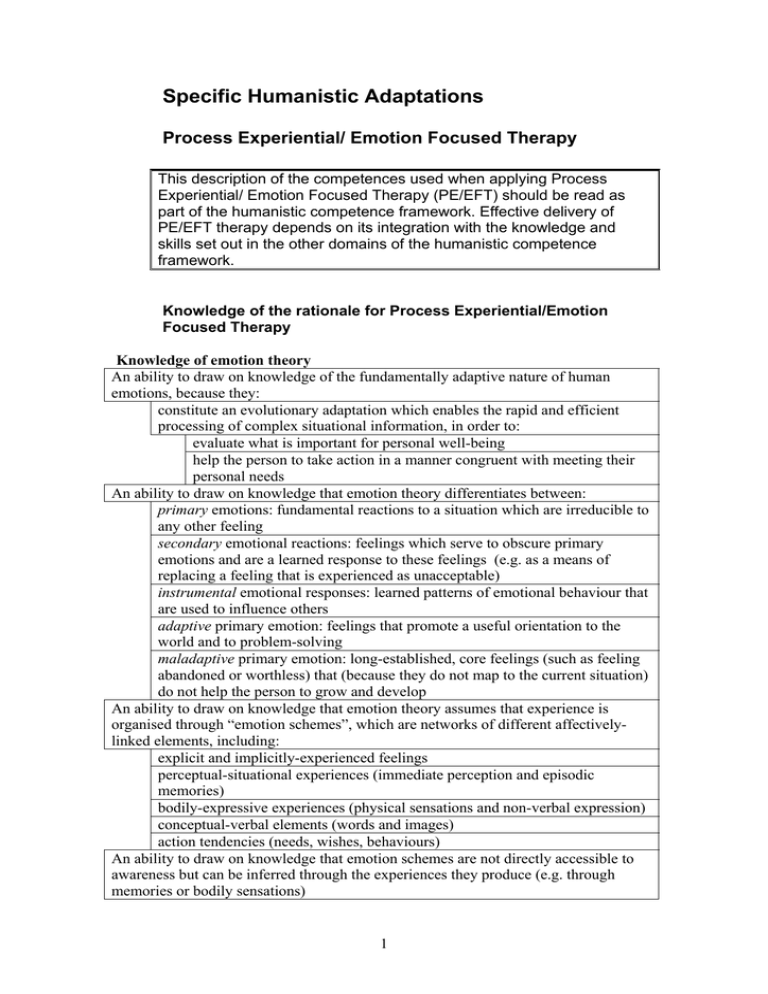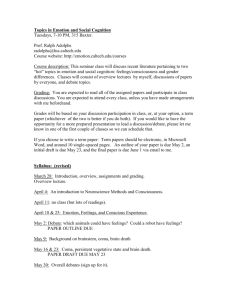Specific Humanistic Adaptations Process Experiential/ Emotion Focused Therapy
advertisement

Specific Humanistic Adaptations Process Experiential/ Emotion Focused Therapy This description of the competences used when applying Process Experiential/ Emotion Focused Therapy (PE/EFT) should be read as part of the humanistic competence framework. Effective delivery of PE/EFT therapy depends on its integration with the knowledge and skills set out in the other domains of the humanistic competence framework. Knowledge of the rationale for Process Experiential/Emotion Focused Therapy Knowledge of emotion theory An ability to draw on knowledge of the fundamentally adaptive nature of human emotions, because they: constitute an evolutionary adaptation which enables the rapid and efficient processing of complex situational information, in order to: evaluate what is important for personal well-being help the person to take action in a manner congruent with meeting their personal needs An ability to draw on knowledge that emotion theory differentiates between: primary emotions: fundamental reactions to a situation which are irreducible to any other feeling secondary emotional reactions: feelings which serve to obscure primary emotions and are a learned response to these feelings (e.g. as a means of replacing a feeling that is experienced as unacceptable) instrumental emotional responses: learned patterns of emotional behaviour that are used to influence others adaptive primary emotion: feelings that promote a useful orientation to the world and to problem-solving maladaptive primary emotion: long-established, core feelings (such as feeling abandoned or worthless) that (because they do not map to the current situation) do not help the person to grow and develop An ability to draw on knowledge that emotion theory assumes that experience is organised through “emotion schemes”, which are networks of different affectivelylinked elements, including: explicit and implicitly-experienced feelings perceptual-situational experiences (immediate perception and episodic memories) bodily-expressive experiences (physical sensations and non-verbal expression) conceptual-verbal elements (words and images) action tendencies (needs, wishes, behaviours) An ability to draw on knowledge that emotion schemes are not directly accessible to awareness but can be inferred through the experiences they produce (e.g. through memories or bodily sensations) 1 An ability to draw on knowledge that emotion schemes help to form “selforganisations” which form the basis of identity or sense of self: a constantly changing multiplicity that achieves a sense of coherence through the integration of different aspects of emotional experiencing An ability to draw on knowledge that emotion theory assumes that a capacity to regulate emotions is essential for effective functioning: to access and amplify emotions that are not in full awareness or are only partially perceived to moderate emotions that are potentially overwhelming An ability to draw on knowledge that emotional regulation is shaped by early attachment experiences An ability to draw on knowledge that the guiding principle for working with emotion is to increase access to, and use of primary adaptive emotion and to reduce the influence of secondary, instrumental and maladaptive emotion Knowledge of how the PE/EFT model conceptualises the origins of dysfunction An ability to draw on knowledge that the PE/EFT model conceptualises psychological dysfunction as occurring: when primary adaptive emotion schemes are not symbolized in awareness, resulting in the person not being aware of what is guiding their thoughts and actions when primary maladaptive schemes are activated, leading to dysregulation and inappropriate responses to current situations when the relationship between different aspects of self is hostile (e.g. where a person experiences a punitive “inner critic”) or oppressive (e.g. where an aspect of the self is suppressed or silenced), leading to: a lack of ready access to feelings significant emotional pain the blocking of primary emotional responses the client feeling stuck and unable to take adaptive action a sense of fragmentation impulsive acts or unwanted habits when there is “unfinished business” in relation to another person (e.g. where the other is experienced as abandoning or violating), leading to: significant unmet needs unresolved emotional reactions (e.g. lingering hurt and resentment) Knowledge of the PE/EFT theory of therapeutic change An ability to draw on knowledge that new meaning and understanding emerges: intrapersonally – through the separation and differentiation of different aspects of the self, and through meaningful contact or exchange between these interpersonally – through meaningful contact or exchange between people from reflecting on experience An ability to draw on knowledge that the PE/EFT model assumes that therapeutic change is most likely when there is meaningful dialogue between aspects of self e.g: the therapist helps the client to experience tolerant, “friendly” contact between different aspects of the client’s self 2 the client is able to attend to significant emotions, aspects of the self and inter/intra-personal processes, and hence to integrate their experience the client is able to focus inwards and to access emotion schemes (hence making aspects of self available for synthesis into experience or action) the client is able to develop new meanings by making a clear distinction between aspects of self and subsequently bringing these into contact with each other An ability to draw on knowledge that new meaning also emerges through a process of meaningful dialogue between client and therapist Ability to apply process experiential methods Ability to develop a formulation of the client’s characteristic modes of experiencing An ability to work with clients to develop a formulation that identifies: the client’s habitual styles of “being” and “doing” (how clients treat themselves; how clients treat others; how they allow others to treat them) the client’s capacity for self-reflection, interpersonal relating and constructive contact with their feelings the client’s early attachment history problematic ways in which clients engage with their feelings, e.g.: where the client: focuses on other people or on external events as a means of avoiding contact with their own feelings uses abstract terms instead of making reference to concrete experience focuses on physical symptoms rather than feelings An ability to develop a shared focus for the therapy An ability to judge the client’s readiness to engage in particular therapeutic tasks An ability to identify “problem markers”: behavioural indicators that the client is ready to work on a particular problem An ability to notice when a range of potential markers is present and to collaborate with the client to identify which to work on An ability to offer and carry out therapeutic tasks signalled by problem markers An ability to adopt an appropriate therapeutic strategy to facilitate exploration of issues which are signalled by markers, e.g.: adopting an empathic stance to facilitate client self-exploration or selfexpression being transparent about problems in the alliance and employing “metacommunication” to build or repair the therapeutic relationship using focusing to help the client access and identify meanings associated with inner experience using trauma retelling, systematic evocative unfolding or meaning protest work to help the client reprocess problematic or painful experiences using two-chair and empty-chair work to facilitate active expression by the 3 client and to heighten and access underlying emotions An ability to help the client maintain a focus on the agreed therapeutic task An ability to complete the process of task resolution : helping the client to access and deepen their experience in the early phases of work helping the client to identify underlying adaptive emotions and processes during the middle phases of work assessing when change has occurred, and supporting the emergence of resolution helping the client to deepen and broaden their understanding of emerging resolutions and their implications bringing work on a task to a close when this is appropriate to the client’s needs and the nature of the task An ability to work with the client to develop strategies that will maintain therapeutic change outside of the therapy sessions Ability to adapt PE/EFT to different client populations An ability to provide a rationale for PE/EFT relevant to the particular client population (e.g., for depressed clients, an ability to explain the importance of accessing emotion and dealing with self-criticism processes) An ability to identify and offer therapeutic tasks relevant to particular client populations (e.g., conflict splits, empty chair work for depression) An ability to adapt therapeutic tasks to issues characteristic of particular client populations (e.g., depressive vs. anxiety splits) Back to Competences Map 4





